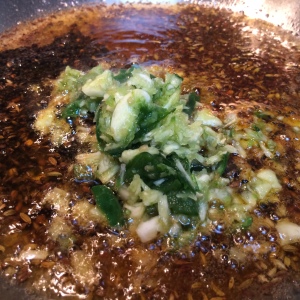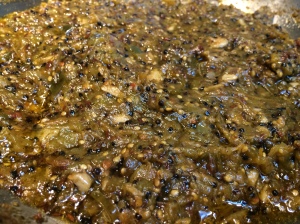If you read my last post, you know that I am trying to rescue my harvest of green tomatoes. I made salsa verde out of some of them, but the question naturally arises—how much salsa verde can one family reasonably eat? The answer is—not much. So on we go to other ideas.
Late Blight
But first, I threw out in my last post that my crop was threatening to be swallowed up by late blight. I did not know this at the time, but my tomatoes were brushing up against history. This is the same disease that once struck potatoes in Ireland, in 1845 precisely, and loosed famine upon the land. The cause of the disease is a pathogen known as water mold. An unassuming name, but it hides some points of interest, as Sherlock Holmes might say. You know the game that kids play where the first question asked is: “animal, vegetable or mineral?” Well, a similar first question to ask about lifeforms is: is it an animal, or a plant? Or a fungus (like mushrooms and yeast), or perhaps a bacteria? So which of these is the water mold?
Neither, it turns out. It is not an animal, nor a plant, nor a bacteria, and not, also, a fungus, though it superficially resembles one. Its is in fact from a separate kingdom of life entirely, known as the oomycetes.
Regardless of its pedigree, it has killer intent when it is found on tomatoes. First brown spots appear on leaves, and they dry and fall. The fruit remains relatively untouched pretty late in the game, which is why I was able to rescue most of them. But eventually greasy dark spots appear on the stem side first, and soon the entire tomato is covered with it. San Francisco’s coolness and fog is quite congenial to Late Blight, so much to my regret, this foe might always be dogging my heels.
Tomato chutney
You know that a foreign vegetable has been completely accepted into Indian cuisine when it undergoes chutneyfication. By this metric, the tomato has become a quintessential Indian vegetable since the Portuguese brought it over in the 16th century. The number of recipes for tomato chutney is immense. Here, though, is one that draws from Bengali cuisine.
Bengali green tomato chutney
Ingredients:
- 4 large garlic cloves
- 4 green serrano chilies
- 4 cups of sliced green tomatoes
- 1/2 cup olive or other oil
- 2 teaspoons cumin seeds
- 2 teaspoons mustard seeds
- 1 teaspoon fenugreek seeds
- 1 teaspoon fennel seeds
- 1 teaspoon nigella seeds
- 1 teaspoon asafetida
- 1 teaspoon red chili powder (optional)
- 2 teaspoon salt
Method:
Pulverize the garlic and chili in a mortar and pestle until it is a paste. Heat the oil in a wide, thick-bottomed pan on a medium-high flame. When it shimmers put in the five types of seeds (cumin, mustard, fenugreek, fennel, nigella). When they sizzle and pop, the asafetida and red chili powders. When they foam up, the garlic chili paste. The paste will cook in a few minutes, but make sure it does not burn. Now the rough-chopped tomatoes go in along with the salt. Toss to combine with oil and spice.
Cook on medium-low for a whole hour, turning occasionally and mashing with the back of the spoon. In an hour, it will have dried quite a bit, and the oil will be gleaming through. Mash once again, let it cool, and empty into a jar.
(Click here to find me on Facebook and here on Twitter.)












Superior save right there. What a delicious sticky rich looking chutney. My tomato seeds are just starting to emerge from the soil and I am already hoarding recipes for the green ones. Cheers for the excellent share 🙂
LikeLike
Thank you Narf. I wish you good luck with your new crop and I hope you get to them before the blight.
LikeLiked by 1 person
We don’t have blight here Aneela but we do have a very short growing season which results in us ending up with lots of green tomatoes 🙂
LikeLike
Reblogged this on Chef Ceaser.
LikeLike
This sounds really delicious and something new to try. Thank you for sharing this.
Simon
LikeLike